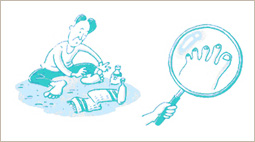Our Services
| Clinic of Diabetic Foot | ||
|---|---|---|
Clinic of Diabetic Foot
Why is the DM foot important?Diabetes Mellitus (DM) has increased for several years and more than 2 million people suffer from the DM and one quarter of them have some problems with their foot. DM foot is one of the most common complications and amputation rate is 15 times higher than that of the normal population. The most important part of the DM foot management is early detection, treatment, and prevention. Long-lasting DM may cause peripheral neuropathy and results in loss of sensation including foot. In this case, patient is not aware of injury to their foot and this may prohibit early detection. Therefore, treatment is delayed in most of the cases and there are few special care centers for DM foot, which result in the chronic problematic wound and unwanted amputation.
EtiologyDiabetes Mellitus impairs the circulation, causes peripheral neuropathy, and impedes immune function to resist bacterial infection. Therefore, though the injury on the foot occurs, patients are not aware of it due to the loss of sensation. Even though it starts with the small wound, as the healing power and the resistance to the infection are suppressed, it spreads rapidly and results in the ulceration or gangrene and makes complication into amputation. Long duration of DM, smoking, poor control of blood sugar worsen the complications relevant to the DM foot. Most of the DM foot begins with trivious wound if the patient pays attention to this, prevention may be feasible. DM patient should be alert on their wounds, especially on the ingrowing toenail, wound resulting from trimming of toenail, callus or blister caused by the tight shoes, vesicles generated by the burn in bathing.
DiagnosisPatients suffering from the diabetes for long time should be alert on the abrupt change of their foot. Even if it seems trifling, patient should go to see the specialist. As it were, if the color of foot becomes red or darkened or if the vesicle or ulceration may be found, patient should not ignore these signs and hesitate visiting the physician. For the accurate evaluation for the DM foot, examination for the sensory function, radiologic examination, bone scan, ultrasound for the blood flow, and angiographic examination may be necessory.
TreatmentThere are two categories in the treatment of DM foot. One is conservative treatment and the other is surgical treatment. For the conservative treatment, various dressing materials, vasodilatators, epithelial growth factor inducing the tissue regeneration, and hyperbaric oxygen therapy are available. All these conservative managements are believed to accelerate the wound healing.
Prevention
ObservationIf the patient has suffered from DM for long time, he or she should make close observation of their own foot every day if there is any bleeding, vesicle, and color change in the toe,. Using the mirror, whole foot including sole should be closely observed daily. If there is any wound, redness, pain or swelling, patients have to go and see the physician.
CleansingISoaking into the hot water or the application of the hot pack on the foot should be avoided due to the risk of unconsciously being burnt. Cleaning with the tepid water and soap is recommended. After washing the foot, complete dryness of foot should be ensured. Moisture between the toes should be dried.
MoisturizingFollowing the complete dryness after cleaning the foot, it is important to moisturize with moisturizer so that foot is not chapped or cracked. If there remains the crack, the risk of bacterial infection is high. However, web space between the toes had better not be kept wet. In our clinic, moisturizer containing the growth factor is recommended for the stabilization of the skin.
Trimming the toenailWhen the patient trim the toenail, special precaution not to make injury is necessary. Any attempt to use chemically reactive material including glacial acetic acid or vinegar should be avoided. Corn, callus, and ingrowing toenail must not be removed recklessly.
General considerationCessation of smoking is strongly recommended because tobacco aggravates the endothelial damage of the blood vessel caused by diabetes. High-heeled shoes had better be avoided and fitting shoes for the patient is recommended. The patient should be familiar with the way of controlling the diabetic foot and regularly followed up at the special clinic.
|
||










